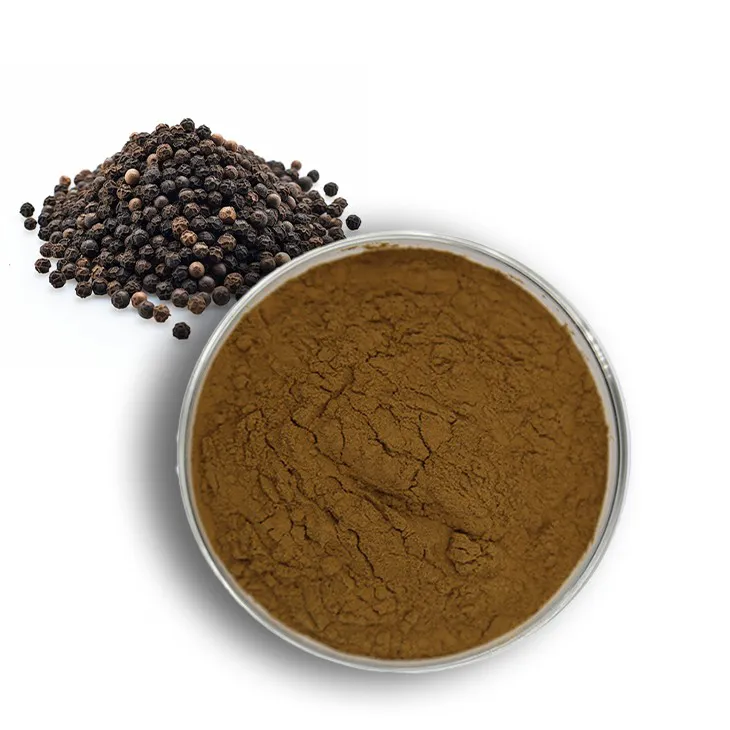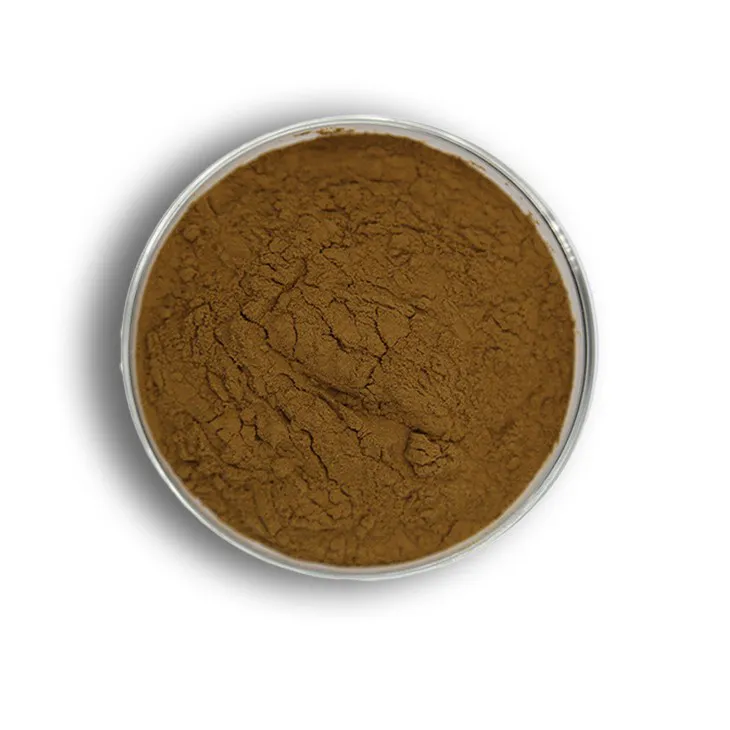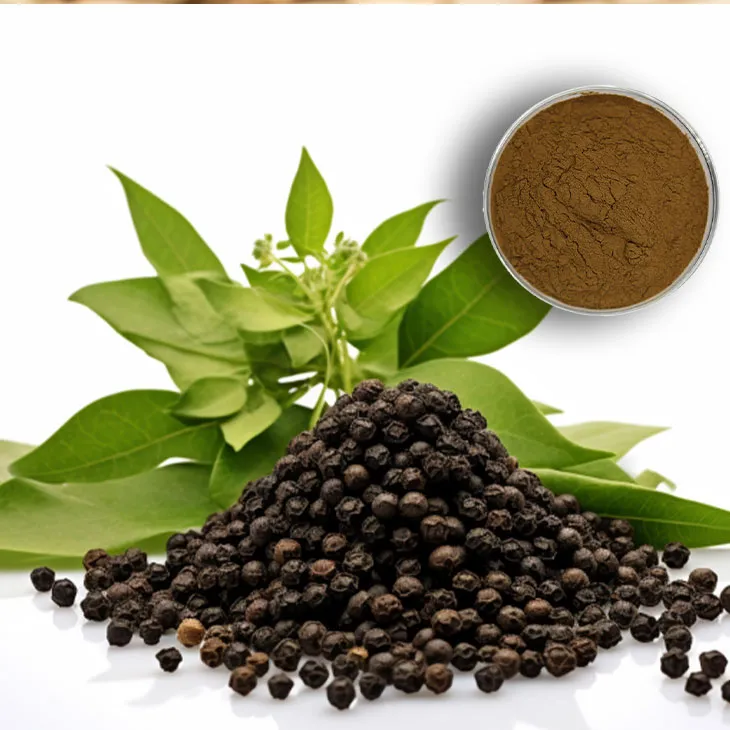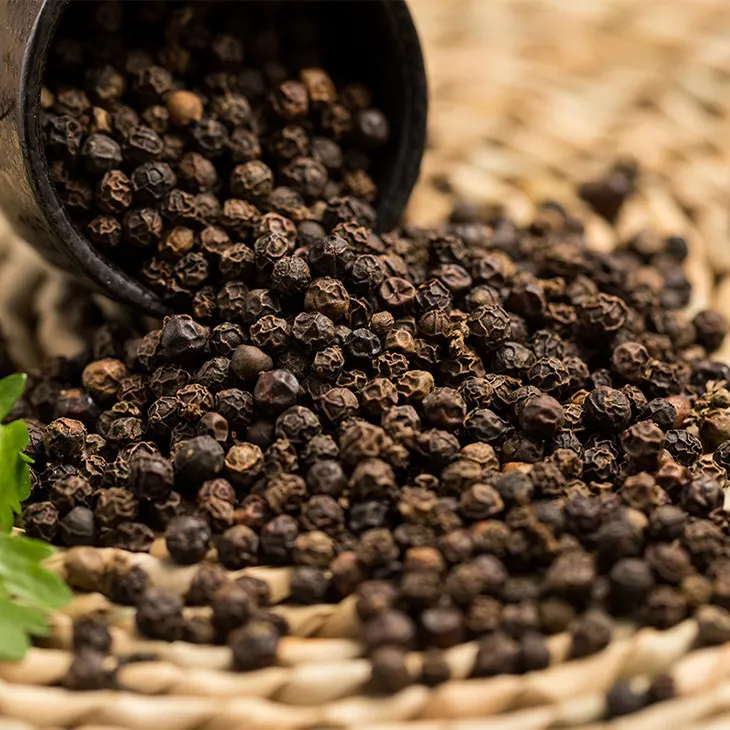- 0086-571-85302990
- sales@greenskybio.com
How to Extract Black Pepper Extract by Steam Distillation.
2024-11-28

1. Introduction
Black pepper (Piper nigrum) is one of the most widely used spices in the world. It not only imparts a characteristic pungent and spicy flavor to food but also has potential health benefits. Steam distillation is a common method for extracting essential oils and other volatile components from black pepper, resulting in Black Pepper Extract. This extract has a wide range of applications in the food, pharmaceutical, and cosmetic industries.

2. Significance of Steam Distillation in Black Pepper Extract Production
2.1 Preservation of Volatile Compounds
Steam distillation is a gentle and effective method for isolating volatile compounds present in black pepper. The volatile components such as piperine, essential oils (including β - caryophyllene, limonene, etc.) are responsible for the characteristic aroma and flavor of black pepper. Steam distillation helps in extracting these compounds without significant degradation. This is crucial as these volatile components are highly valuable in various applications. For example, in the food industry, they are used to enhance the flavor of products, and in the pharmaceutical and cosmetic industries, they may possess bioactive properties.
2.2 Selectivity
Steam distillation offers a certain level of selectivity. It can preferentially extract the volatile and semi - volatile components from black pepper while leaving behind non - volatile substances such as polysaccharides and proteins. This selectivity is important as it allows for the production of a relatively pure extract rich in the desired aromatic and bioactive compounds. It also simplifies the downstream processing as the extract obtained is more concentrated in the relevant components compared to other extraction methods that may extract a broader range of substances.
2.3 Scalability
Steam distillation can be easily scaled up from a laboratory - scale process to an industrial - scale production. This is significant for meeting the high - demand for Black Pepper Extract in various industries. Whether it is a small - scale operation for producing high - quality extracts for niche markets or a large - scale industrial production for mass - market products like food flavorings and pharmaceuticals, steam distillation can be adjusted accordingly. The basic principles remain the same, although larger equipment and more precise control systems are required for industrial - scale operations.

3. Equipment Used in Steam Distillation of Black Pepper
3.1 The Still
The still is the central piece of equipment in steam distillation. There are different types of stills that can be used for black pepper extraction. One common type is the water - bath still. It consists of a vessel that contains the black pepper sample and water. The water is heated, and the steam generated passes through the black pepper, carrying the volatile components with it. Another type is the steam - generated still, where an external source of steam is introduced into the chamber containing the black pepper. This type of still is often more efficient and is commonly used in industrial - scale operations as it can provide a continuous and controlled supply of steam.
3.2 Condenser
The condenser is an essential component in the steam distillation setup. Its role is to cool down the steam - vapor mixture coming from the still, causing the vapor to condense back into a liquid. There are two main types of condensers used: the water - cooled condenser and the air - cooled condenser. The water - cooled condenser is more efficient and is widely used, especially in larger - scale operations. It consists of a coiled tube through which the steam - vapor mixture passes, and water is circulated around the tube to cool it. The air - cooled condenser, on the other hand, uses air to cool the vapor, and it is more suitable for small - scale or portable distillation setups.
3.3 Receiver
The receiver is used to collect the condensed liquid, which is the black pepper extract. It is usually a flask or a container with a narrow neck to prevent the loss of volatile components during collection. The receiver should be clean and dry before use to avoid contamination of the extract. In some cases, a graduated receiver may be used to measure the volume of the extract obtained during the distillation process.
3.4 Heating Source
The heating source is required to generate steam in the still. In a water - bath still, a heating mantle or a hot plate can be used to heat the water. For steam - generated stills, boilers or steam generators are used to produce high - pressure steam. The choice of heating source depends on the scale of operation and the type of still used. It is important to have precise control over the heating temperature to ensure efficient and consistent distillation.

4. The Process of Steam Distillation of Black Pepper
4.1 Preparation of Black Pepper
- First, the black pepper should be properly sourced and of high quality. It is advisable to use whole black peppercorns rather than ground pepper as the latter may have lost some of its volatile components during grinding.
- The black peppercorns are then washed gently to remove any dirt or impurities. After washing, they are dried thoroughly. This can be done at room temperature or in a low - temperature oven to avoid the loss of volatile compounds.
- Once dried, the black peppercorns may be crushed or coarsely ground. This step increases the surface area of the pepper, allowing for better interaction with the steam during distillation.
4.2 Loading the Still
- The prepared black pepper is loaded into the still. If using a water - bath still, the pepper is placed in the vessel along with an appropriate amount of water. The ratio of black pepper to water should be carefully determined based on the desired extraction efficiency. For example, a ratio of 1:5 (black pepper: water by weight) may be a starting point, but this can be optimized depending on the specific characteristics of the pepper and the equipment used.
- If using a steam - generated still, the black pepper is placed in the distillation chamber, and the steam inlet is properly connected to ensure a proper flow of steam through the pepper.
4.3 Heating and Distillation
- The heating source is activated. In the case of a water - bath still, the water is slowly heated until it reaches a gentle boil. This generates steam, which then passes through the black pepper. In a steam - generated still, the steam from the external source is introduced into the chamber at a controlled pressure and flow rate.
- The steam - vapor mixture containing the volatile components from the black pepper then travels to the condenser. The temperature and pressure conditions during distillation should be carefully monitored. For black pepper, a distillation temperature in the range of 100 - 150 °C (depending on the equipment and the specific components to be extracted) and a pressure close to atmospheric pressure are typically used.
4.4 Condensation
- As the steam - vapor mixture enters the condenser, it is cooled. In a water - cooled condenser, cold water is circulated around the condenser tube to rapidly cool the vapor. In an air - cooled condenser, air is blown over the condenser surface to achieve cooling.
- The vapor condenses into a liquid, which is the black pepper extract. The condensed liquid then drips or flows into the receiver.
4.5 Collection and Monitoring
- The black pepper extract is collected in the receiver. The volume of the extract collected can be monitored over time. This can provide information about the extraction efficiency and the progress of the distillation process.
- The quality of the extract can also be monitored during the collection process. This can be done by observing its color, clarity, and aroma. Any deviation from the expected characteristics may indicate a problem with the distillation process, such as overheating or contamination.

5. Post - distillation Handling of Black Pepper Extract
5.1 Separation of Phases
After distillation, the black pepper extract may consist of two or more phases. For example, there may be an aqueous phase and an oil phase. Separation of these phases is often necessary. This can be achieved through simple decantation in cases where the phases are clearly distinguishable. For more complex mixtures, techniques such as centrifugation or the use of a separatory funnel may be required. The separated phases can then be further processed or analyzed depending on their intended use.
5.2 Filtration
The black pepper extract may contain some solid particles or impurities even after distillation. Filtration is an important step to remove these impurities. A filter paper or a membrane filter can be used. Filtration not only improves the clarity of the extract but also helps in removing any remaining non - volatile substances that may have been carried over during distillation. This results in a purer and more stable extract.
5.3 Storage
- Proper storage of black pepper extract is crucial to maintain its quality. The extract should be stored in a dark, cool, and dry place. Exposure to light, heat, and moisture can cause degradation of the volatile components and lead to a change in flavor and aroma.
- It is advisable to store the extract in amber - colored glass bottles or sealed containers made of suitable materials such as stainless steel or high - density polyethylene. These containers can protect the extract from light and prevent the ingress of moisture and air.
- The storage temperature should be maintained within a specific range. For long - term storage, a temperature of around 4 - 10 °C is ideal, although short - term storage at room temperature may be acceptable depending on the stability of the extract.
6. Unique Properties of Black Pepper Extract
6.1 Aroma and Flavor
The black pepper extract has a distinct and complex aroma and flavor profile. It contains a rich blend of volatile compounds that contribute to its characteristic spicy, warm, and slightly woody notes. These flavor and aroma characteristics make it highly valuable in the food industry for flavoring a wide range of products such as meats, sauces, and bakery items. In addition, the aroma of black pepper extract can also have a positive impact on the overall sensory experience in products like perfumes and candles in the cosmetic industry.
6.2 Bioactive Compounds
Black pepper extract is rich in bioactive compounds such as piperine. Piperine has been studied for its potential health benefits, including its role in enhancing the bioavailability of certain drugs and nutrients. It may also have antioxidant, anti - inflammatory, and antimicrobial properties. These bioactive properties make black pepper extract a potentially valuable ingredient in the pharmaceutical and nutraceutical industries. For example, it can be used in dietary supplements or as an active ingredient in topical creams for its anti - inflammatory effects.
6.3 Solubility
The solubility of black pepper extract can vary depending on the composition of the extract and the solvent used. In general, it has some solubility in organic solvents such as ethanol and ethyl acetate, which makes it suitable for use in formulations where these solvents are present. However, its solubility in water is relatively limited, which can be a factor to consider when formulating products that require aqueous solubility. This property also affects its extraction and purification processes as different solvents may be required to achieve optimal extraction and separation.
7. Conclusion
Steam distillation is a valuable method for extracting black pepper extract. It offers a way to isolate the volatile and bioactive components of black pepper while maintaining their integrity. The proper understanding of the equipment used, the distillation process, post - distillation handling, and the unique properties of the extract is essential for the successful production and utilization of black pepper extract in various industries. With continued research and development, the potential applications of black pepper extract are likely to expand further in the future.
FAQ:
What is the principle behind steam distillation for black pepper extract?
The principle of steam distillation for black pepper extract lies in the fact that when steam is passed through black pepper, the volatile compounds in the pepper, which are responsible for its characteristic flavor and aroma, vaporize. These vaporized compounds then rise along with the steam. Since the boiling point of water is lower than the decomposition temperature of these volatile components, they can be separated without being damaged. The steam - volatile compound mixture is then condensed, and the resulting liquid contains the black pepper extract along with water, which can be further separated.
What equipment is typically used in the steam distillation of black pepper extract?
Typical equipment used includes a steam generator to produce the steam. A distillation flask is needed where the black pepper sample is placed and the steam is introduced. A condenser is crucial for cooling down the vaporized mixture of steam and volatile compounds from the black pepper. A receiving flask is used to collect the condensed liquid which contains the black pepper extract. Additionally, tubing is required to connect the different components of the apparatus and ensure the proper flow of steam and condensed liquid.
How is the quality of the black pepper extract affected by steam distillation?
The quality of the black pepper extract obtained through steam distillation can be affected in several ways. If the temperature and pressure during distillation are not properly controlled, it may lead to the degradation or loss of some volatile compounds, thereby affecting the flavor and aroma of the extract. The duration of distillation also plays a role. If it is too short, not all the desirable volatile components may be extracted, and if it is too long, it may cause over - extraction of unwanted substances or degradation of the valuable components. Moreover, the quality of the starting black pepper material, such as its freshness and variety, also impacts the quality of the final extract.
What are the main volatile compounds in black pepper extract obtained by steam distillation?
The main volatile compounds in black pepper extract obtained by steam distillation include piperine, which is also responsible for the pungency of black pepper, along with various terpenes such as limonene, α - pinene, and β - caryophyllene. These terpenes contribute to the characteristic aroma of black pepper. There are also other minor volatile components that together create the complex flavor and aroma profile of the black pepper extract.
How is post - distillation handling of black pepper extract carried out?
After distillation, the black pepper extract, which is in a mixture with water, needs to be separated. This can be done through methods like liquid - liquid extraction or using a separatory funnel if the extract and water have different solubilities in a particular solvent. The extract may also need to be further purified to remove any remaining impurities. This can involve filtration to remove solid particles and sometimes further chemical purification methods depending on the intended use of the extract. Additionally, the extract may be concentrated to increase the concentration of the active volatile compounds for better storage and utilization.
Related literature
- Steam Distillation in Spice Extract Production: A Comprehensive Review"
- "The Chemistry of Black Pepper Volatiles and Their Extraction"
- "Optimizing Steam Distillation for High - Quality Black Pepper Extract"
- ▶ Hesperidin
- ▶ citrus bioflavonoids
- ▶ plant extract
- ▶ lycopene
- ▶ Diosmin
- ▶ Grape seed extract
- ▶ Sea buckthorn Juice Powder
- ▶ Beetroot powder
- ▶ Hops Extract
- ▶ Artichoke Extract
- ▶ Reishi mushroom extract
- ▶ Astaxanthin
- ▶ Green Tea Extract
- ▶ Curcumin Extract
- ▶ Horse Chestnut Extract
- ▶ Other Problems
- ▶ Boswellia Serrata Extract
- ▶ Resveratrol Extract
- ▶ Marigold Extract
- ▶ Grape Leaf Extract
- ▶ blog3
- ▶ blog4
-
Organic Dandelion Root Extract, Australia.
2024-11-28
-
The best bitter gourd extract in 2024.
2024-11-28
-
The best baicalin in nature.
2024-11-28
-
Chinese lily extract manufacturers.
2024-11-28
-
Nature's best β - carotene.
2024-11-28
-
Standard - process Coenzyme Q10.
2024-11-28
-
Bulk purchase of pomegranate extract.
2024-11-28
-
Beta Carotene
2024-11-28
-
Acerola Extract
2024-11-28
-
Angelica sinensis extract
2024-11-28
-
Astaxanthin
2024-11-28
-
Alfalfa Meal
2024-11-28
-
Green Tea Extract
2024-11-28
-
Clove Powder
2024-11-28
-
Chasteberry Extract
2024-11-28
-
Phellodendron Extract
2024-11-28
-
Tamarind extract powder
2024-11-28





















